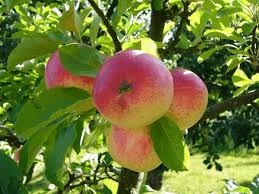
When I was growing up, the crabapple trees in front the neighbors' houses were also valued for crabapple fights, providing a plentiful supply of ammunition, a sharp zing, and usually no lasting harm. The remainders would find their way into the kitchen, where they would usually be poached in port wine with cinnamon to adorn holiday plates.
Crabapples are wild apples, and they are adaptable to any reasonable soil that is not too wet or too dry. They prefer deep, well-drained soil, but they can thrive in rocky or gravelly soil. “Crabs” rarely grow more than 20 feet high, although they range from a mere 6 feet for some of the spreading types to almost 40 feet for robust varieties.
In home gardens, crabapples are often kept pruned to eight feet. At that height, they are useful as patio trees, as specimens in smaller gardens, or as options for planting under power lines.
You will find bare-root crabapples in nurseries early next year, but you can plant them in containers at any time. Crabapples do well in lawns, and it is easy to keep them small enough to line driveways or walkways. They tolerate wetter soil than other ornamental flowering trees and are prone to fewer disease and pests.
The difference between apples and crabapples is really just fruit size. Fruit smaller than two inches in diameter is classified as a wild apple or crabapple. Larger fruit is considered an apple.
If you have ever tasted a raw crabapple, you either appreciated its sharp bitterness or you quickly spit it out. But even the bitterest fruit can be made palatable by poaching in a spiced syrup, or by roasting gently in an oven or by a fire. And regardless of the fruit's bitterness, birds and other wildlife always appreciate them.
Hard cider is making a comeback, and farmers are planting more crabapples to meet the needs of cider makers. Crabapples are high in pectin, so you can use them to help gel other fruit preserves.
In the landscape, crabapples are interesting in every season. Winter exposes their contorted crowns and branches that are often short and spur-like with defensive thorn-like twigs. Their twisted trunks make dramatic silhouettes against winter skies.
In spring, crabapples bloom before their leaves unfurl. Blossoms are usually generous, although some varieties bloom heavily only every other year. Many bloom in that cheerful soft pink that we associate with apple blossoms. The leaves that follow can be light green to dark purple. Fruits often hang in clumps or clusters, like cherries.
Apples and roses belong to the same genus. I have noted that the roses in my garden with the longest history have the most vicious thorns. I can easily imagine herbivores deciding that there were easier plants to eat. Wild crabapples protect their scrappy, survivor heritage with thorns, too.
Crabapples can be as small in diameter as one-half inch and as large as two inches. Fruit colors range from soft yellow to bright red, dark burgundy, purple and russet. There are more than 200 named varieties, with new ones coming to market each year. With so many crabapples, how does one choose?
If you want an upright tree, consider Malus ‘Profusion'. It reaches 20 feet and has green foliage with bronze tips, purplish-pink flowers and red fruit. For a 10-foot spreading shrub with dramatic zigzag branches, fragrant and profuse white blossoms and tiny red fruit, consider M. ‘Sargentii'. Many gardeners plant M. ‘Dolgo' for its cherry-like clusters of tasty crabapples. You will have to taste for yourself to find the crabapples that appeal to you.
Crabapples are susceptible to a few pests and diseases. Look for varieties resistant to fireblight and scab. Your local nursery can provide solutions for coddling moths and powdery mildew. Crabapples do not need yearly pruning, except to remove dead or diseased limbs or to shape.
Workshop: Napa County Master Gardeners will conduct a workshop on “Rose Pruning and Maintenance” on Saturday, January 17, from 10 a.m. to 2 p.m., at University of California Cooperative Extension, 1710 Soscol Avenue, Napa. This workshop will feature demonstrations on rose bushes to show and explain proper pruning techniques. Master Gardeners will discuss various types of roses, common rose diseases and routine maintenance including watering and fertilizing.Online registration (credit card only)Mail-in registration (cash or check only).
Master Gardeners are volunteers who help the University of California reach the gardening public with home gardening information. Napa County Master Gardeners ( http://ucanr.org/ucmgnapa/) are available to answer gardening questions in person or by phone, Monday, Wednesday and Friday, 9 a.m. to Noon, at the U. C. Cooperative Extension office, 1710 Soscol Avenue, Suite 4, Napa, 707-253-4143, or from outside City of Napa toll-free at 877-279-3065. Or e-mail your garden questions by following the guidelines on our web site. Click on Napa, then on Have Garden Questions? Find us on Facebook under UC Master Gardeners of Napa County.